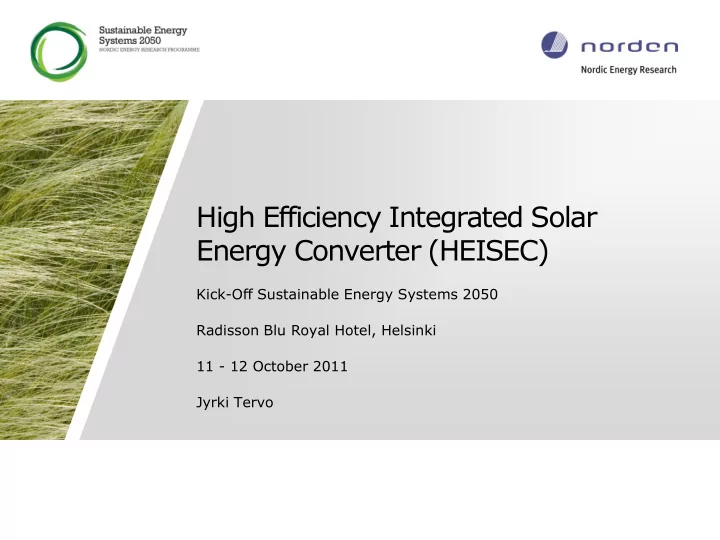

High Efficiency Integrated Solar Energy Converter (HEISEC) Kick-Off Sustainable Energy Systems 2050 Radisson Blu Royal Hotel, Helsinki 11 - 12 October 2011 Jyrki Tervo
Introduction • Project focuses on photon enhanced thermionic emission (PETE) utilization in energy production. • Introduced in 2010 by Schwede et al (Nature materials, Vol. 9(2010), 762 - 767) • PETE conversion combines photovoltaic and thermionic effects into a single process (first step) • Device includes a secondary heat engine to utilize waste heat (second step) • Dual effect is suggested to reach conversion efficiencies higher that 50% 2
Device principles Schwede et al, 2010 • Solar radiation is absorbed by the cathode. The cathode emits blackbody radiation both away from the device and towards the anode. • Electron current from the cathode JC is absorbed by the anode. • Excess heat in the anode due to electrons and photons is delivered to a thermal cycle 3
Our objectives • To demonstrate and verify the phenomena by measurement • To study the means to optimize materials properties (new materials, effects of nanotailoring and alloying properties) • To build a working demonstrator that can be utilized in further research and development (different design approaches) 4
Our consortium • KTH, School of Information and Communication Technology, Microelectronics and Applied Physics (Professor Sebastian Lourdudoss) • Technical University of Denmark, DTU Nanotech, Department of Micro and Nanotechnology (Professor Ole Hansen) • Fortum Corporation, Corporate R&D, New Technologies (Manager Eero Vartiainen) • Picosun Ltd, R&D Manager Pekka J. Soininen • VTT Technical Research Centre of Finland, Microsystems and Nanoelectronics (Professor Jouni Ahopelto) & Advanced Materials (Senior Scientist Jyrki Tervo) 5
Our plan • WP1: Systems specifications and modelling (Leader: KTH) – Months 1 – 5 • WP2: Materials testing and evaluation (Leader: DTU) – Months 4 – 32 • WP3: Demonstrator set-up (Leader: VTT) – Months 6 – 32 • WP4: Evaluation of the demonstrators (Leader: DTU) – Months 20 – 25 • WP5: Coordination activities (Leader: VTT) – Months 1 – 36 6
… and in the end • The project will result in a clear vision of the applicability of the presented technology (photon enhanced thermionic emission) in energy production and scaling of such methods. • It is anticipated that industry driven R&D projects will emerge as a result of the project. • Project results will also include new IPR and scientific publications. The materials issues will be emphasized in the project as well as different structural combinations to find optimal solutions for different environments (including Nordic climate). • In long term the successful results of the project may be implemented as emerging business and spin-off companies that fit into the emerging clean- tech area. 7
Recommend
More recommend